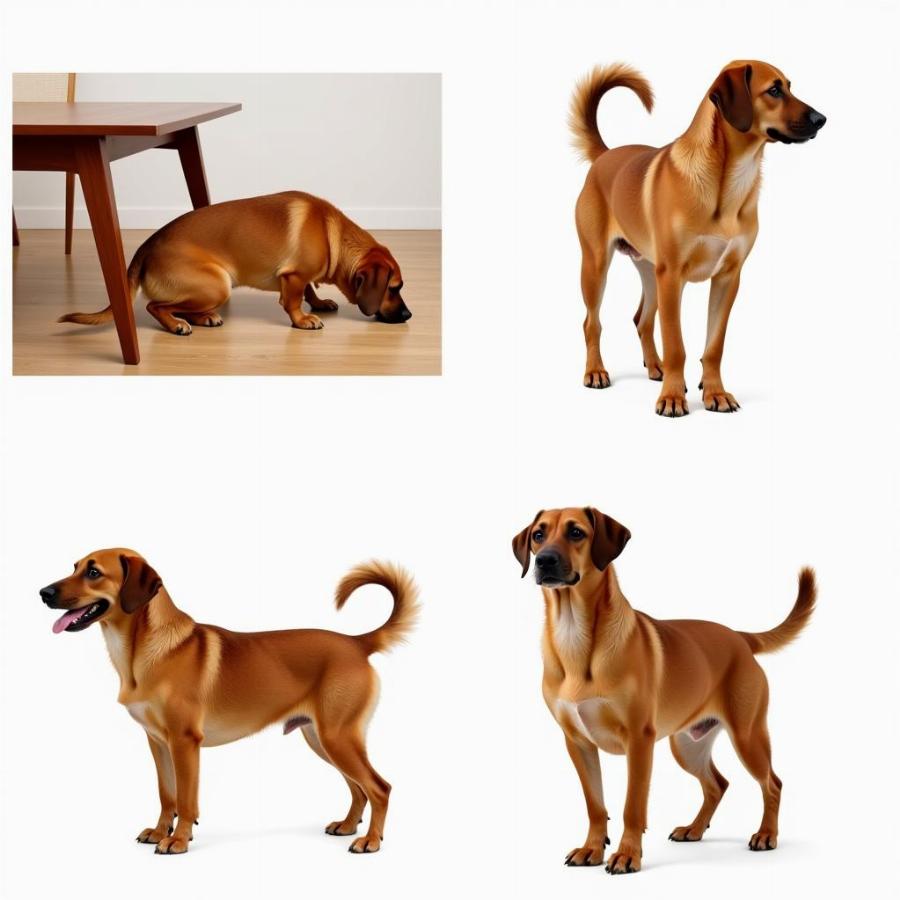Understanding your dog’s tail wags is like learning a new language. While it’s tempting to assume a wagging tail always equals happiness, dog tail meaning is far more nuanced than that. A wagging tail can signal excitement, anxiety, or even aggression. By understanding the subtle differences in their tail movements, you can gain valuable insights into your furry friend’s emotional state. This guide will delve into the complex world of dog tail language, helping you decipher what your dog is truly communicating.
The Many Meanings Behind a Wagging Tail
A wagging tail isn’t always a sign of a happy dog. The speed, height, and direction of the wag, combined with other body language cues, all contribute to dog tail meaning. A fast, wide wag, especially with a relaxed body posture, generally indicates happiness and excitement. However, a slow, hesitant wag, particularly with a lowered body and ears, could signify anxiety or fear. Even the direction of the wag can offer clues – a wag biased to the right side generally indicates positive emotions, while a left-biased wag may suggest negative emotions.
Beyond the Wag: Other Tail Positions and Their Meanings
 Different dog tail positions and their meanings
Different dog tail positions and their meanings
While wagging is the most common tail movement, other tail positions hold significant meaning. A tail tucked between the legs often signals fear or submission. Conversely, a tail held high and stiff can indicate alertness, dominance, or even aggression. A tail held horizontally usually means a dog is relaxed and observing its surroundings. Understanding these different positions helps you better interpret your dog’s overall emotional state.
Why Do Dogs Wag Their Tails?
Dogs wag their tails as a primary form of communication. They lack the complex vocalizations of humans and rely heavily on body language. Tail wags are a way for them to express their emotions and intentions to other dogs and humans.
How Can I Tell if My Dog’s Tail Wag is Friendly or Not?
Look at the entire picture, not just the tail. A friendly wag is usually loose and relaxed, accompanied by a happy facial expression and soft eyes. A stiff, high wag with intense stares or bared teeth can be a warning sign.
Tail Language Across Breeds
Different breeds have different tail structures and wagging styles. A Corgi’s naturally short tail will express emotion differently than a Golden Retriever’s long, feathered tail. Some breeds, like the Siberian Husky, have a curled tail, which adds another layer of complexity to their tail communication. Remember to consider breed-specific characteristics when interpreting dog tail meaning.
Conclusion: Become Fluent in Dog Tail Language
Understanding dog tail meaning is crucial for building a strong bond with your canine companion. By paying attention to the subtleties of their tail movements and combining those observations with other body language cues, you can gain a deeper understanding of their emotions and needs. This knowledge empowers you to respond appropriately and create a more harmonious relationship with your furry friend.
FAQ:
-
Do all dogs wag their tails? While most dogs wag their tails, some breeds with naturally short or curled tails may express themselves differently.
-
Can a dog wag its tail while sleeping? Yes, dogs can wag their tails while dreaming, often indicating a happy or exciting dream.
-
What does a slow tail wag mean? A slow tail wag can indicate uncertainty, anxiety, or appeasement.
-
Is a high, stiff tail wag always a sign of aggression? Not always, but it can be a sign of alertness, dominance, or potential aggression, so it’s important to observe other body language cues.
-
Why does my dog chase its tail? Tail chasing can be a sign of boredom, anxiety, or even medical issues. If it becomes excessive, consult a veterinarian.
You Might Also Be Interested In:
dogs licking each others ears This article explores why dogs lick each other’s ears, offering insights into their social dynamics.
black widow spider bite on a dog Learn about the dangers of black widow spider bites on dogs and what steps to take if your dog is bitten.
is pure balance good for dogs This article provides information on the Pure Balance dog food brand and whether it’s a suitable choice for your canine companion.
Beaut Dogs: Your Trusted Source for Dog Care Information
Beaut Dogs is your one-stop resource for everything related to dog care, offering expert advice and practical tips on all aspects of dog ownership. rabbit shooting dog medieval art From breed information to health and nutrition guidance, we’re dedicated to providing you with the knowledge you need to raise a happy and healthy dog. dog eats me out When you need support, contact us via Email: [email protected] to receive detailed and accurate answers from Beaut Dogs.